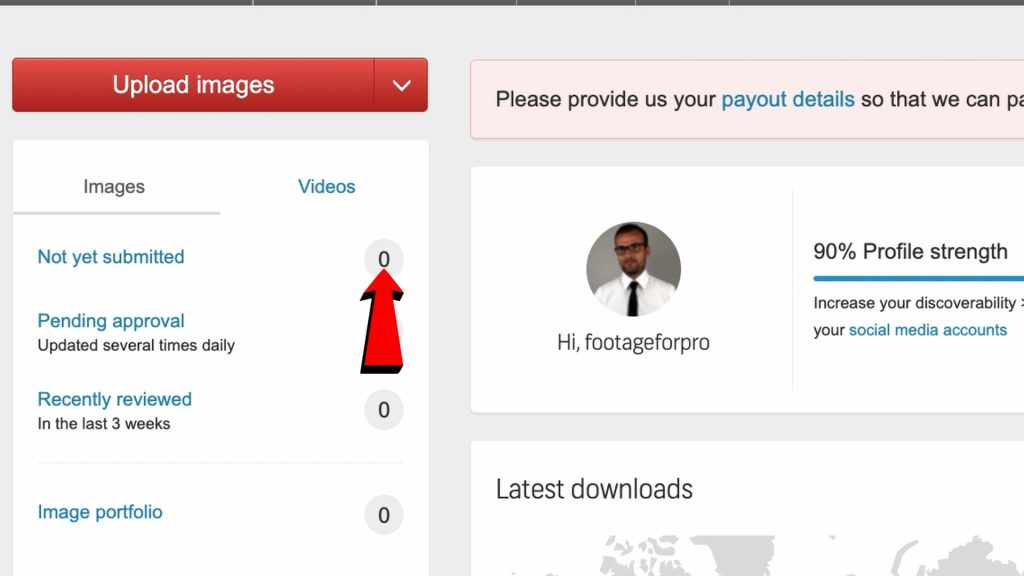Thinking about sharing your news content on Shutterstock? You’re in the right place! Shutterstock isn’t just for stock photos and videos anymore — it’s also a platform for news content that can reach a global audience. Whether you’re a journalist, a freelance correspondent, or a media organization, uploading your news stories can open new doors for visibility and monetization. In this guide, we’ll walk you through the entire process step-by-step, making it easy and straightforward. Let’s get started and turn your news content into a valuable asset that can be accessed by millions worldwide!
Prerequisites and Requirements for Uploading News Content

Before you dive into uploading your news stories to Shutterstock, it’s important to understand the prerequisites and requirements to ensure your content qualifies and is ready for submission. Here’s what you need to know:
1. Account Setup
- Shutterstock Contributor Account: You must create a free contributor account on the Shutterstock website. This account will be your hub for uploading, managing, and tracking your news content.
- Verification Process: Shutterstock may require identity verification to ensure authenticity, especially for news content. This could include submitting a government-issued ID or other relevant documents.
2. Content Eligibility
- Originality: Your news footage or stories need to be original and not infringe on copyrights or trademarks.
- Newsworthiness: The content should be timely, relevant, and provide real value or insight into current events.
- Quality Standards: High-resolution videos and images are preferred. Ensure your content is well-lit, clear, and professionally shot.
3. Technical Specifications
- File Formats: Videos should typically be in formats like MP4 or MOV. Images should be in JPEG or PNG formats.
- Resolution: For videos, a minimum of 1080p is recommended. Photos should be at least 4 megapixels.
- File Size: Keep your files within Shutterstock’s size limits — usually up to 50GB per file for videos and up to 100MB for images.
4. Legal and Ethical Considerations
- Consent: Make sure you have the necessary permissions or releases, especially if your content includes recognizable individuals or private property.
- Copyright: Avoid infringing on third-party rights. Only upload content you own or have rights to share.
- Privacy: Be cautious about revealing sensitive personal information unless you have explicit consent to do so.
5. Preparing Your Content
- Editing: Edit your footage or images to ensure clarity, stability, and proper framing.
- Metadata: Prepare descriptive titles, keywords, and captions to make your content discoverable.
- Organization: Keep your files organized for easy uploading and management.
Getting these prerequisites right sets a smooth path for your upload process and increases the chances of your news content being accepted and appreciated on Shutterstock. Now that you know what’s needed, you’re all set to start creating and preparing your news stories for submission!
Preparing Your News Content for Upload

Before you hit that upload button, it’s super important to make sure your news content is properly prepared. Think of this step as getting everything ready for a big presentation — you want your content to look professional and be easy for others to understand. So, let’s walk through what you should do to prepare your news content for Shutterstock.
First things first, organize your content. This means gathering all your images, videos, or articles in one place. If you have multiple pieces, consider creating folders or labels so you can easily find what you need during the upload process.
Next, check the quality of your content. Shutterstock is pretty strict about quality standards, so ensure your visuals are sharp, well-lit, and free of noise or blurriness. For videos, make sure they’re stable, properly exposed, and have good audio if applicable.
Now, let’s talk about formatting. For images, stick to common formats like JPEG, PNG, or TIFF. For videos, MP4 or MOV are usually the best options. Make sure your files are named clearly and descriptively — this helps both you and Shutterstock when managing your uploads.
Another crucial step is metadata — that’s the info about your content, like titles, descriptions, tags, and keywords. Write descriptive, accurate titles and detailed descriptions that explain what your news content is about. Use relevant keywords to help users find your work easily. For example, if you’re uploading news photos of a political rally, include keywords like politics, rally, protesters, city name, date.
Don’t forget about copyright and licensing. Ensure that you have the rights to upload and share your news content. If your content includes recognizable people, locations, or trademarks, you may need model releases or permissions to avoid copyright issues.
Finally, double-check the content for any sensitive or confidential information that shouldn’t be shared publicly. It’s always better to review thoroughly before uploading to avoid any issues later on.
How to Upload News Content to Shutterstock
Now that your content is prepped and ready, it’s time to upload! The process is straightforward, but here are some tips to make it smooth and successful.
Step 1: Log into your Shutterstock Contributor account. If you don’t have one yet, sign up on their website — it’s quick and easy.
Step 2: Navigate to the upload page. Once logged in, look for the “Upload” button or link, usually found in your dashboard or menu. Click it to start the upload process.
Step 3: Select your files. Use the file browser to choose the news content you want to upload. You can upload multiple files at once by selecting several or dragging and dropping them into the upload window.
Step 4: Fill in the metadata. For each piece of content, add a descriptive title, detailed description, and relevant keywords. Be specific — the more accurate your metadata, the easier it is for others to find your work.
Step 5: Choose licensing options. Shutterstock typically offers Standard and Extended licenses. Review the options and select the one that fits your content’s intended use. Don’t worry — you can always update this later if needed.
Step 6: Review your uploads. Before submitting, double-check that all the information is correct and that files are properly uploaded. Make sure your images or videos meet Shutterstock’s technical requirements listed in their guidelines.
Step 7: Submit for review. Once everything looks good, hit the “Submit” button. Your content will then go into Shutterstock’s review process, which usually takes a few days.
And that’s it! After approval, your news content will be live and available for licensing on Shutterstock. Remember, the key is to stay organized and attentive throughout the process. Happy uploading!
Tips for Ensuring Your Content Meets Shutterstock Standards
Uploading news content to Shutterstock is an exciting opportunity, but it’s essential to make sure your submissions meet their standards. After all, Shutterstock has specific guidelines to maintain high-quality visuals and accurate news coverage. Here are some friendly tips to help you get your content approved and stand out in the news section:
Understand the Content Guidelines
- Authenticity is key: Always ensure your news images are truthful and accurately represent the story. Avoid staged or overly manipulated photos.
- Relevance: Focus on current, newsworthy topics that are relevant to a broad audience.
- Quality matters: Use high-resolution images with sharp details. Blurry or poorly lit photos are unlikely to get approved.
Pay Attention to Technical Details
- Resolution: Shutterstock recommends images be at least 4 MP (megapixels). For videos, aim for a minimum of 1080p quality.
- File Format: Upload in accepted formats like JPEG for images and MP4 for videos.
- Color Profile: Use sRGB color space to ensure colors are consistent across devices.
Respect Copyright and Privacy
- No copyrighted content: Make sure you own the rights to all images or videos you upload.
- People rights: Obtain model releases if recognizable individuals are featured, especially in news-related content.
- Property rights: Avoid including private property or trademarks unless you have permission.
Stay Current and Sensitive
News content often involves sensitive or controversial topics. Always approach these subjects with respect and professionalism. Avoid sensationalism, and strive to provide balanced, truthful coverage. Additionally, stay updated on Shutterstock’s content policies, as guidelines can evolve over time.
Use Clear and Accurate Descriptions
When submitting your news content, write detailed, accurate titles and descriptions. Include relevant keywords to improve discoverability. This helps reviewers understand the context of your content and increases the likelihood of approval.
By following these tips, you’re putting your best foot forward and increasing the chances your news content will meet Shutterstock’s standards. Remember, quality, authenticity, and relevance are the cornerstones of successful submissions!
Understanding Shutterstock’s Review Process for News Content
Once you’ve uploaded your news content, you might be wondering, “What happens next?” Shutterstock has a review process designed to ensure that all content aligns with their quality and policy standards. Knowing what to expect can help you stay patient and prepared for the review period.
The Review Timeline
Typically, Shutterstock reviews new uploads within a few business days—often between 24 to 48 hours. However, during busy periods or for high volumes of submissions, it might take a bit longer. It’s a good idea to plan your uploads accordingly, especially if you need content published quickly for breaking news.
The Review Criteria
Shutterstock’s review team examines each piece of content based on:
| Aspect | What They Look For |
|---|---|
| Quality | High-resolution, clear, well-composed images and videos without artifacts or distortions. |
| Relevance | Content that accurately depicts recent news events and aligns with current affairs. |
| Authenticity | Genuine, unaltered images that truthfully represent the news story. |
| Copyright & Legal | Ownership rights, model releases, and adherence to privacy laws. |
| Adherence to Policies | Content that complies with Shutterstock’s content guidelines, including avoiding offensive or sensitive material unless properly contextualized. |
Possible Outcomes
- Accepted: Your content passes review and becomes available for licensing.
- Rejected: If your submission doesn’t meet Shutterstock standards, you’ll receive feedback explaining the reasons. Common issues include poor quality, misrepresentation, or copyright concerns.
- Request for Edits: Sometimes, Shutterstock may ask you to revise your content—like cropping or adjusting the image—to meet their standards.
What to Do If Your Content Is Rejected
Don’t be discouraged! Review the feedback carefully, make the necessary adjustments, and resubmit. Often, small improvements can turn a rejected image into an approved one. Remember, patience and attention to detail are your best tools here.
Stay Informed
Keep an eye on your email notifications and your Shutterstock contributor dashboard. They often provide updates on the review status and any additional steps you might need to take.
Understanding Shutterstock’s review process helps you manage expectations and refine your submissions. With patience and a clear grasp of their criteria, you’ll be well on your way to successfully sharing your news content on the platform!
Managing and Tracking Your Uploaded News Content
Once you’ve uploaded your news content to Shutterstock, the next step is to stay organized and keep track of your submissions. Managing your uploads effectively can help you understand what’s performing well, identify areas for improvement, and ensure your portfolio remains up-to-date.
Here’s how you can manage and track your news content effectively:
- Use the Contributor Dashboard: Shutterstock provides a user-friendly dashboard where you can view all your uploads. Here, you can see the status of each file—whether it’s pending review, approved, or rejected.
- Monitor Performance Metrics: Once your content gets approved, you can track how it’s performing. Metrics like views, downloads, and earnings give you insight into what your audience prefers.
- Organize Your Content: Keep your files organized by creating folders or labels within your device or cloud storage. This makes it easier to locate specific news articles or images for future updates or re-uploads.
- Update Your Portfolio Regularly: As news evolves, consider updating or adding new content related to trending topics. Frequent updates can boost your visibility on Shutterstock.
- Set Goals and Review Progress: Decide on monthly or quarterly targets for uploads and earnings. Regularly reviewing your progress helps you stay motivated and adjust your strategy if needed.
Remember, consistency is key. The more organized and attentive you are to your uploads and their performance, the better you can refine your strategy and maximize your earnings from your news content.
Common Issues and Troubleshooting During Upload
Uploading news content to Shutterstock can sometimes come with its own set of challenges. Don’t worry—most issues are straightforward to resolve once you understand the common pitfalls and how to troubleshoot them.
Let’s go over some of the typical problems and how to fix them:
| Issue | Possible Cause | Solution |
|---|---|---|
| Upload Fails or Gets Stuck | Slow internet connection or file size too large |
|
| Rejection Due to Content Quality or Restrictions | Content doesn’t meet Shutterstock’s guidelines or contains restricted material |
|
| Metadata or Keywords Not Accepted | Using inappropriate or irrelevant keywords |
|
| Slow Review Process | High volume of submissions or technical delays |
|
Additional Tips:
- Always double-check your files before uploading to avoid errors.
- Keep your software and browser updated for smoother uploads.
- Maintain clear and detailed descriptions to reduce rejection risk.
By understanding these common issues and knowing how to troubleshoot, you’ll make your upload process smoother and more efficient. Remember, patience and attention to detail go a long way in making your news content shine on Shutterstock!
Conclusion and Best Practices for Successful News Content Uploads
Uploading news content to Shutterstock can be a rewarding way to showcase your work and reach a global audience. To ensure your submissions are successful and meet platform standards, it is essential to follow some key best practices. First, always verify that your content complies with Shutterstock’s content guidelines, including quality, originality, and copyright requirements. High-resolution images and videos with clear focus and proper lighting tend to perform better and are more likely to be accepted.
Organizing your files meticulously before upload can save time and prevent errors. Use descriptive, keyword-rich titles and tags to improve discoverability. Consider creating a consistent naming convention for your files to streamline your workflow. Additionally, pay close attention to metadata accuracy; providing detailed and relevant information helps reviewers understand your content and accelerates approval.
- Maintain Quality: Ensure your content is sharp, well-lit, and properly exposed.
- Use Appropriate Keywords: Think like a buyer and include relevant tags and descriptions.
- Stay Updated: Regularly review Shutterstock’s submission guidelines and industry trends.
- Respect Copyright Laws: Only upload content you own or have permission to share.
By applying these best practices, you maximize your chances of successful uploads and increased visibility within the Shutterstock marketplace. Consistency, attention to detail, and adherence to platform standards are your keys to building a reputable portfolio and generating sustainable income from your news content.

